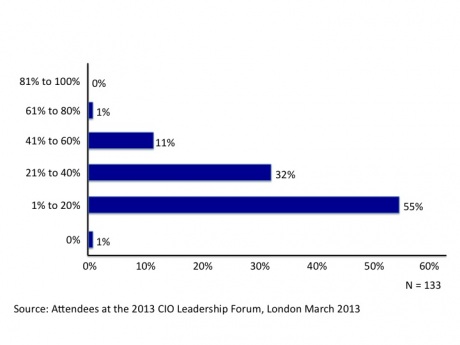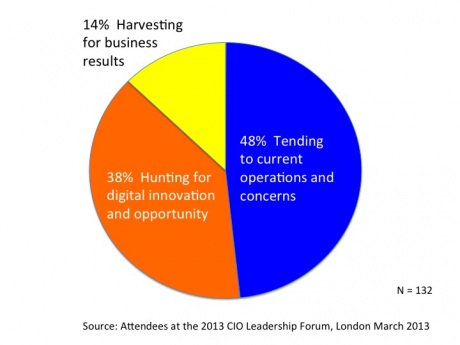The quest to better IT realisation
Earlier this month almost 300 CIOs from across Europe flew into London’s Terminal 5 to participate in the 2013 Leadership Forum. “Digital Enterprise and Beyond” is the theme of the event reflecting the inflection point facing CIOs as traditional IT issues give way to emerging Technology challenges and opportunities.
During the event we conducted a number of polls to get a pulse from the CIOs. The results were revealing and provide a context for the lessons learned from this year’s event.
How much of technology’s potential has your enterprise realised?
This question sought to get a sense of how far enterprises have gone to implementing and realising the value of technology. The global overall average from this year’s 2013 CIO Agenda came in at 43 per cent. Here are the results from CIOs attending this year’s forum.
Which role describes the majority of your work for the coming year?
Hunting and Harvesting in a Digital World is the title of this year’s CIO agenda report. The title points to the need for CIOs to expand their roles and responsibilities beyond just ‘tending’ to current concerns and operations. CIOs have spent the last decade tending for economic, financial and technology reasons, but it’s time to break out of that behaviour. Hunting and harvesting, the expanded roles for IT, are not new but their time has come. Hunting for digital innovation and opportunity is an imperative to create the top line growth needed for success. Harvesting refers to realising business results from technology.
Tending, the proxy for current operations and running the business, formed the majority of work for IT, as it should. It was surprising that only 14 per cent of CIOs see harvesting for business results as their major activity. Surprising in the sense, given the premium executives place on business results.
Which type of activity do you think will be most important to your success in 2013?
Bloated is a description applicable to too many IT strategies, plans and priorities. It seems that ‘doing more with less’ carried equal emphasis between the less – cost and the more – stuff.
Unfortunately in many IT organisations, more responsibilities with fewer resources create strategic constipation and technology attention deficit disorder. For those reasons, the 2013 CIO agenda report concentrated on defining recommendations of what CIOs should Do New, Re Do, Undo and Don’t Do. Emphasising a range of things and that CIOs need to stop doing some things is the idea behind categorising the recommendations rather than just piling on.
CIOs believe that in 2013 they will concentrate on doing new things, responding to new challenges, and expanding roles and responsibilities as shown in the figure below.
IT has historically been measured by new projects, systems, solutions etc., more than the business results it realises. Given the range of competing and conflicting priorities facing CIOs, it may be good to concentrate on reforming IT practices and removing past practices that are no longer relevant.
The 'Digital Enterprise' and beyond
This year’s leadership forum occurs at a critical time for IT, technology and CIOs across Europe. It was great to work with CIOs on issues ranging from digital strategy, new digital practices and the imperatives associated with raising IT’s core performance. From the presentations, interactive sessions, networking and workshops the energy, concentration and commitment reflect both the challenges we all face as well as our capacity to make the transition into digital business and beyond.
Mark McDonald is a group vice president and head of research in Gartner Executive Programs.



















